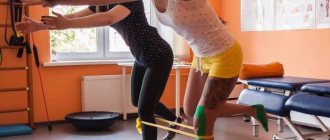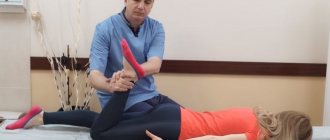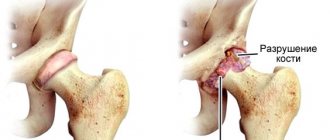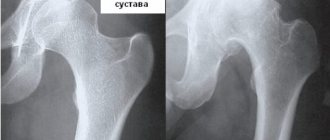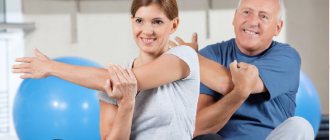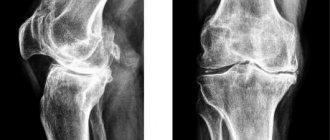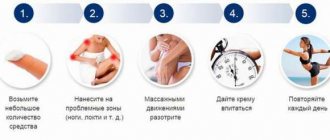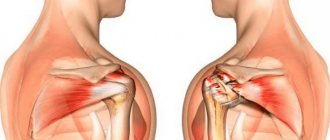Due to high stress, the knee joint often undergoes age-related deformation. However, often the problem does not arise because of the years lived. Damage to the osteoarticular surfaces as a result of injuries, sprains, ruptures and microtears of muscles are the most relevant situations for knee damage. The treatment process is far from quick, since therapy is carried out conservatively and surgically. But any treatment option requires exercises to strengthen the knee joint. Exercise therapy not only promotes speedy rehabilitation after surgery for any ailments, but also helps strengthen muscles and stabilize the ligamentous apparatus of the lower extremities.
The knee joint is most often affected because it has a large range of motion.
Therapeutic effect
The muscles and ligaments of the entire lower limb take part in the work of the knee. The main task of the knee joint is to extend, flex and rotate the tibia relative to the thigh. They are especially effective when the hip joint is in a bent position. On the side of the lower leg, the sartorius and gastrocnemius muscles are involved in the process of active movements, and rotational actions in a bent state are achieved due to tension in the tibial fascia. The maximum number of connections of muscle fibers and ligaments are located in the popliteal fossa. It is this segment that is impacted by isometric gymnastics - modern exercises for developing the knee joint after surgery.
Movement in the knee is a complex process that involves the work of many anatomical structures of the limb. Damage to any part of the chain leads to events leading to the formation of diseases of the knee joint.
Physical therapy (physical therapy) alone cannot cure any of the joint diseases. But it helps strengthen ligaments and muscles, which provides benefits during complex conservative therapy or after surgery. Exercise therapy effectively facilitates leg movements with arthrosis, which is especially important for older people. Regular muscle exercises increase their physical endurance and tendons become elastic. Videos of exercises for the treatment of arthrosis can be viewed in publicly available sources.
Knee replacement in the Czech Republic: guarantees, prices, rehabilitation, reviews and statistics.
Find out more
Features of joint gymnastics
Like any workout, joint gymnastics will be beneficial if performed with the correct technique and following safety standards. Let's see what should be taken into account during exercise, whether such gymnastics can be performed as a warm-up, and what you need to know about training at the age of 50 and older.
- The exercises are performed from top to bottom, starting from the neck and ending with the ankle, in order to consistently work out all groups of joints.
- In joint gymnastics, sudden movements that can lead to dislocations are excluded, and therefore all exercises are performed at a slow pace.
- To ensure tangible health benefits, perform joint exercises regularly, at least 4-5 times a week.
- It is best to do exercises for your joints in the morning, when they feel the most stiffness. A short warm-up at a gentle pace can be done in the evening or between work to relieve tension in the neck, back and limbs.
- When performing joint gymnastics exercises, you need to keep your back straight, squeezing your shoulder blades together, and lifting your chin.
- You should not exercise immediately after eating, wait 2 hours. It is best to perform gymnastics before breakfast on an empty stomach to jump-start your metabolism and stimulate digestion.
- When performing joint gymnastics exercises, watch your breathing; it should be even and calm. Try not to breathe too deeply or too often, or hold your breath.
- If you feel pain in certain joints, then work them out slowly, paying special attention to them during training. But this does not apply to injured joints that need rest.
- Combine joint exercises with yoga and stretching to not only strengthen your joints, but also improve your body flexibility.
- For classes you will only need comfortable clothes; you can practice barefoot at home; a special mat is not required.
Joint gymnastics as a warm-up
Before strength training or running, it is recommended to warm up to warm up your ligaments and muscles. To warm up, you can use a complex of joint gymnastics and add a few dynamic stretching exercises.
Warm-up should not last too long, 5-15 minutes is enough. During warm-up, movements should be vigorous, but not sharp, in order to increase blood flow to the muscles without causing injury. Immediately after warming up, you can start exercising or running.
General selections for warming up and stretching:
- 10 exercises to warm up before training for 3-5 minutes
- 30 pre-workout warm-up exercises + plan
Joint gymnastics as a separate workout
If you perform joint gymnastics as a separate workout, then its duration should be at least 20-30 minutes, otherwise you will not be able to work out the whole body well. In addition, the duration of each exercise is important.
To warm up, 8-10 repetitions for each exercise are enough, but in a full workout, the number of repetitions should be at least 12-15, possibly more. Gymnastics should be performed at a slow pace, moving slowly, with full amplitude. After training, you can do yoga or stretching, as the body is sufficiently warmed up and ready for stretching exercises.
Joint gymnastics for ages 50+
Due to the specifics of its implementation and the characteristics of its impact on the body, gymnastics for joints is recommended for people in adulthood and old age. It is especially important for women to maintain healthy joints during menopause, as hormonal changes cause bones to thin out, leading to osteoporosis and other diseases. To maintain the health of the musculoskeletal system for a long time, it is recommended to regularly perform simple exercises, lead an active lifestyle and adhere to a proper diet.
In old age, sudden movements and impact training should be avoided. This means that running should be replaced with walking, and active exercises with calm gymnastics for the joints. It is advisable to perform it daily in order to enjoy freedom of movement, and not suffer from stiffness and pain in the back, legs, and neck.
If you want to feel energetic at any age and delay the aging of your body, then joint gymnastics, which has almost no contraindications, will help you. Perform simple exercises every day that will give you lightness in your body and good spirits, as well as excellent health and good mood.
Implementation principles
No matter how severe the injury to the knee joint, gymnastic training will always be beneficial for the patient. Physical therapy is not able to cure the affected joint, but it can improve its function, as well as stabilize blood flow and activate muscle tone before surgery. There are two sets of knee exercises.
Of these, 1 part of the training is intended to facilitate movements and relieve pain during conservative treatment. It also serves as an excellent help in preparing the patient for various operations, especially endoprosthetics. And part 2 of the training complex is used for rehabilitation after traumatic ligament damage, as well as to speed up walking in the postoperative period.
The main rules of therapeutic exercises are presented below.
- Regular use. Using any exercise once will not bring any benefit. In addition, when performed dynamically on an untrained knee, it can lead to further impairment of active movements. The first part of the exercises must be performed for at least 3 months, and after surgery on the knee joint - before independent, easy manipulations in the endoprosthetic joint.
- Gradual increase in loads. Exercising too intensely will lead to ligament rupture and muscle strain.
- You can't overdo it. With regular training, 30-40 minutes a day is enough for the full effect of gymnastics.
- Monitoring by medical staff. The beginning of any training is carried out under the supervision of a doctor or exercise therapy instructor. In the postoperative period, the condition of the leg is monitored by rehabilitation specialists, who develop an individual complex of therapeutic effects of dosed physical activity.
- Symmetry. Even if only one joint is affected, both should work fully. This will ensure uniform blood flow and facilitate movement in both limbs.
- Strictly no pain. If exercises cause serious discomfort, you should stop using them. Only an experienced specialist will give further instructions on physical activity. A little pain is not an obstacle to exercise, since straightening the muscles and increasing the range of motion in the injured knee is impossible without it.
Every patient suffering from pathology in the knee joint is recommended to use a set of therapeutic exercises. For mild injuries, training will help to quickly restore the functioning of the joint; for severe injuries, it will ensure the success of postoperative rehabilitation. Although exercise therapy cannot completely cure a knee, it can improve the condition of all muscles and tendons involved in movement.
What equipment and clothes to choose for training
You need to train in a ventilated room, on a non-slip floor or a special mat. This will protect you from falling and injury. For classes you will need equipment, such as an expander, collapsible dumbbells, fitball, massage roller. With it, exercises will not only be more interesting, but also more effective.
Exercise in comfortable clothes made of clean, breathable fabric. Never exercise in flip-flops or house slippers. The sole of sneakers or sneakers should be flexible and have shock-absorbing properties. Do you prefer stretching exercises? Opt for shoes with non-slip soles.
If you have difficulty moving your knee joints, perform 2 times a day, for example, the following exercises:
Techniques of Pavel Evdokimenko
The main focus of author's gymnastics is to improve the functional condition of the knees. Pavel Evdokimenko’s technique is excellent for complete assistance in the conservative treatment of arthrosis, as well as for preoperative preparation of the patient. The essence of the classes is static and dynamic training of the muscles and tendons responsible for the functioning of the joint. The slow cycle alternates with the fast one, which ensures maximum participation of the entire lower limb in the treatment process.
Doctor Evdokimenko.
The static part involves fixing the leg in a certain position, which maintains muscle shape in tension. Dynamic exercises provide adequate blood flow and the necessary elasticity of the ligamentous apparatus.
Below are typical healing movements proposed by Pavel Evdokimenko.
- Knee extension.
You will need a chair for this exercise. Starting position – sitting with your feet on the floor. The essence of the exercise is slow extension of the knee joint followed by fixation. The leg should be held in an extended state for up to 1 minute, then slowly return to its original position. For the effect, 2 static workouts per day are enough. Then the exercise should be repeated in dynamic mode with a multiplicity of up to 15 times. You can use one leg and put pressure on the other. - Lying knee extension.
Quite simple but effective physical training. Starting position – lying on your back. Both legs are bent at the knees and the heel is pressed to the floor. It is necessary to raise your leg, straightening it at the knee joint. Hold in this state for 2 minutes, then slowly lower. After 2 static exercises, repeat 15 times in dynamic mode with each lower limb. Perform with both legs. - Asymmetrical movements.
The starting position is lying on the floor, the right leg is bent at the knee joint, the left leg is extended. It is necessary to alternately change the position of the leg - straighten the right leg and bend the left leg at the same time. Then the bent leg must be lifted off the floor and held suspended for up to 2 minutes. In dynamic mode, repeat the exercise up to 20 times. Hands along the body. - Raising your toes. The exercise does not directly develop the knee joint, but is necessary to strengthen the calf muscles, which play a critical role in the movement of the joint. The workout is simple - standing on your feet, heels pressed to the floor, you need to rise onto your toes. Maintain this position for as long as possible. Then repeat in dynamic mode up to 15 times.
Even regular use of Pavel Evdokimenko’s technique is not able to heal the joint. But it is excellent as preoperative preparation, which will allow the patient to quickly recover after endoprosthetics.
For arthrosis of the knee joint
With age, degenerative changes occur in the knee - the joint space narrows, the amount of synovial fluid decreases, the range of active movements decreases - this is how osteoarthritis occurs, which most often affects people over 50 years of age. Conservative methods can only slow down its progression, but only surgery can radically eliminate the problem. However, the exercise therapy complex facilitates the condition of patients in any situation. On the one hand, gymnastics helps reduce pain and facilitate movements, on the other hand, it helps prepare for surgery and recovery after it. Therefore, when the knee joint is damaged, physical therapy will help all people.
With grade 2 gonarthrosis, intense movements are required to maximally strengthen the muscles and ligaments. With the help of therapeutic exercises, it is necessary to delay the progression of the disease and prolong the joy of full functioning of the knee joint. Below are the most relevant exercises for intense knee development.
- Pendulum.
Starting position – sitting on a chair. The legs should hang down freely, so it is important to choose its height so that the heels do not touch the floor. It is necessary to make rhythmic movements in the “back and forth” direction. The number of repetitions is not important, but it is advisable to spend at least 15 minutes training for each leg. You can use a tourniquet to increase the load. - Bending backwards. Starting position – standing, with emphasis on the wall. The essence of the exercise is to bend the knee with intense movements, but the heel is facing in the direction opposite to the support. The frequency is also not important; the training time is at least 10 minutes.
No emphasis? Lie down on the floor.
- "Running while sitting." Starting position: on a chair, feet pressed to the floor. The essence of the training is alternately or simultaneously raising and lowering the lower limbs bent at the knees. It turns out to be a kind of running, only in a sitting position. Completion time: at least 10 minutes.
A chair with a back is better.
- Squats.
This widespread exercise is excellent for grade 2 knee arthrosis. The main goal is not the strength of the training, but the maximum flexion of the knee joints under the weight of the body. The frequency of repetitions depends on physical capabilities - optimally up to 15 times. You can hold onto a support and do half squats.
With grade 3 arthrosis, it will not be possible to restore movement in the knee joint. Further progression is inevitable, so the exercises are aimed at strengthening the muscles and ligaments responsible for activity in the joint. Exercise therapy in this situation is necessary for preoperative preparation for endoprosthetics.
The most relevant exercises are presented below:
- Mini squats.
Gentle bending of the legs under the influence of the muscles of the thigh and legs. The essence of the exercise is small squats until the knees are bent. Then slowly return to the starting standing position. You should perform up to 15 repetitions. Maintain an even body position. - Light swaying of the legs.
A high chair is needed so that the lower limbs can hang freely. The essence of the exercise is to grab the thigh 5 cm above the knee and rub it back and forth. At the same time, move the knee joint with pendulum-like movements. The task is not in the number of repetitions, but in the intensity of massaging the thighs with your hands. The goal of the training is to improve venous outflow from the injured knee. A tourniquet will help. - Hitting your heels. A useful exercise for stabilizing the ligamentous apparatus. Its essence is simple - while sitting on a chair, alternately tap your heels on the floor, but so that the vibration is felt in the knee. Duration – 10 minutes per day.
- Pinwheel. Starting position – sitting on a chair or standing. The goal of the workout is to develop the muscles of the thigh and lower leg. The essence of the exercise is to perform rotational movements in the knee joint with the greatest possible amplitude. A full-fledged “pinwheel” will not work, since the changes with arthrosis of the 3rd degree are great. But 10-15 minutes a day is enough to strengthen muscle tissue not only in the legs, but also in the thighs.
Training for grade 3 arthrosis of the knee joint should begin from the moment the prospect of surgical treatment appears. Even with the planned endoprosthetics after 3 months, regular exercise helped a lot for quick recovery after surgery.
Knee replacement in the Czech Republic: guarantees, prices, rehabilitation, reviews and statistics.
Find out more
Joint gymnastics
Joint gymnastics is a set of physical exercises aimed at warming up joints to improve their mobility, as well as to increase the elasticity of ligaments and tendons. The result of such gymnastics is the elimination of stiffness, pain and tension in the back, neck, legs and arms.
The benefits of joint gymnastics
Joint gymnastics is similar to warming up before training or running, but differs from it in duration and more thorough work on joint groups. A full workout for joints brings great benefits to the body:
- “awakens” metabolism if you do the workout in the morning;
- eliminates morning stiffness of joints in patients with arthritis;
- accelerates blood circulation, saturates the body with oxygen and improves metabolism;
- maintains spinal mobility at any age;
- promotes beautiful posture, and also improves the sense of balance and coordination of movements;
- tones muscles and warms up the body before sports activity;
- preserves the health of joints, ligaments and tendons for a long time;
- allows you to delay age-related diseases in older people;
- has a calming effect on the nervous system;
- invigorates and lifts the mood.
Simple joint gymnastics has a positive effect on health and immunity, and therefore is recommended for almost everyone, because it has almost no contraindications.
Contraindications for joint exercises
Gymnastics for joints is recommended for the elderly, people during the period of rehabilitation after illness, pregnant women, as well as anyone who wants to improve their well-being and improve their health. Despite the benefits and safety of joint exercises, before starting training, check the list of contraindications, of which there are not many:
- hypertension and other problems with the cardiovascular system;
- severe diseases of internal organs;
- bruises and injuries to the back and limbs;
- infectious diseases accompanied by nausea and fever;
- seasonal colds at the initial stage;
- joint diseases for which physical activity is prohibited.
If you feel good, then joint gymnastics is a must for you, because it will give you energy, good mood and significantly improve your quality of life.
Selections for daily stretching for the whole body:
- Daily Standing Stretch: 10 Exercises Without a Mat
- Daily stretching while lying down: 10 exercises (you can even do it in bed)
- Daily back stretches in a chair: 10 exercises in the office
5 reasons to regularly do joint exercises
If you still doubt the need for joint gymnastics, then we are ready to give 5 more arguments in its favor:
- You can prevent the occurrence of osteochondrosis, osteoporosis, arthrosis and other diseases of the musculoskeletal system due to age-related changes and a sedentary lifestyle. At the same time, regular targeted load on the joints normalizes metabolic processes and maintains their health.
- You will forget about back and knee pain, and finally overcome carpal tunnel syndrome or carpal tunnel syndrome, which is typical for many office workers. If you suffer from local pain in the joints, then gymnastics will help get rid of the discomfort.
- You will become more alert and energetic thanks to the freedom of movement that you will have.
- You will find a great way to calm down and find inner balance, because joint exercises relieve nervous tension just as well as yoga.
- You will prevent sudden sprains, dislocations and other injuries caused by insufficient warming up of muscles and joints.
Gymnastics for joints can be done as a separate workout or warm-up before sports; its benefits remain in any case.
For gonarthrosis of the knee joint
Dystrophic processes in the knee joint will inevitably lead to depletion of cartilage tissue and a decrease in the secretion of synovial fluid. This lesion is called gonarthrosis. The disease leads to complete immobility in the joint, which makes it impossible not only to walk, but also to get out of bed. With grades 1 and 2 of gonarthrosis, physical therapy can relieve pain and improve motor capabilities. But the more the disease progresses, the less chance there is to improve the quality of life with osteoarthritis. However, for gonarthrosis of any degree, exercise therapy will help strengthen the muscular system, as well as stabilize venous and arterial blood flow. In the future, the radical operation will completely return the joy of movement to the patient, and the exercises performed before and after will sharply shorten the rehabilitation period.
The higher the degree of joint damage, the more gentle the training should be. Isometric gymnastics helps, aimed at improving blood flow in the knee. Its main advantage for gonarthrosis is the direction of its effect on the vessels and muscles directly involved in the functioning of the joint. Below are the most popular exercises.
- Shifting. Starting position – sitting on a chair. The essence of the exercise is to alternately raise the knees up due to movements in the calf muscles. With arthrosis of the 2nd degree, you can perform it at a fast pace, and with more severe lesions - slowly.
Can be performed standing.
- Knee forward.
Performed in a standing position. The essence of the training is an alternate lunge with the knee bent at a right angle forward, supporting the other leg. You can strengthen the exercise by simultaneously bending your torso back. Repeatability up to 15 times. At the end point the knee should be 90 degrees. - Alternating leg raises.
Performed while sitting on a chair. Since it is often impossible to fully straighten the leg at the joint, you can use a lighter version of the exercise. It is necessary to perform leg raises to the maximum possible extension at the knee. Multiplicity – at least 15 times for each limb. Do it slowly!
Gonarthrosis cannot be cured with exercise. Only surgery can radically change a patient’s life. However, before and after it, gymnastics is absolutely necessary for the speedy rehabilitation of the patient.
Joint gymnastics: 20 exercises
We have selected for you the best joint gymnastics exercises, which are recommended to be performed as a complex one after the other. Do each exercise slowly and smoothly, avoiding sudden movements that are traumatic for the joints.
Head tilts
Place your feet shoulder-width apart, place your hands on your waist, and keep your head level. Bend your neck to the side, then forward, the other way, back, and so on in a circle. Perform joint gymnastics exercises slowly, avoiding sudden movements. Tilts of the head warm up the cervical spine, preventing muscle tension and pain in this area.
How much to do: 5-7 reps on each side
Head rotation
Place your hands on your waist and keep your head straight. Lower your chin down and rotate your neck from side to side, moving along an arcuate path. Do not throw your head back, avoid sudden movements, perform the exercise slowly and smoothly. In joint gymnastics, much attention is paid to working out the cervical spine, which is considered problematic for many. This exercise improves neck flexibility and relieves tension from long periods of sitting.
How much to perform: 5-7 rotations on each side
Shoulder rotations
Stand up straight and lower your arms straight down. Rotate your shoulders without regard to the movements of your arms, which should be relaxed. Perform rotations in the shoulder joints, moving in a circle, first forward and then back. The exercise promotes mobility and flexibility of the shoulders, increasing their range of motion.
How much to do: 5-10 reps clockwise, 5-10 reps counterclockwise
"Butterfly"
Bend your elbows at an angle of 90 degrees and raise them in front of you. Raise your arms to the sides with full amplitude, and then bring them together. An exercise from joint gymnastics develops the mobility of the shoulder joints, preventing the occurrence of injuries and pain. Additionally, the “butterfly” strengthens the muscles of the arms and back if the shoulder blades are brought together at the end point.
How many to perform: 10-15 repetitions
"Scissors"
Extend your arms straight out to the sides and then bring them together so that one arm is on top of the other. Spread your arms to the sides and bring them together again so that the other hand is higher. Perform scissors with full range of motion, but without sudden movements, to develop the shoulder joints, and not harm them. This exercise not only improves shoulder flexibility, but also strengthens your arms.
How many to perform: 10-15 repetitions
Circular rotations of the arms
Standing straight, spread your arms straight to the sides. Perform circular rotations in the shoulder joints, moving up, forward, down, and to the sides. You can repeat the movements in reverse order to work out the joints as much as possible. An excellent exercise from joint gymnastics is recommended to be performed during any sports warm-up, as it warms up the shoulder joints well.
How much to do: 5-10 reps clockwise, 5-10 reps counterclockwise
Raising your arms up
And one more complex exercise from joint gymnastics to warm up the shoulder joints and arms in general. Stand up straight, lower your arms along your body. Start raising your arms up above your head: first through the sides, then stretching them forward in front of you. Alternate between arm raises, stretching your shoulder joints and engaging your core, back, and trapezius muscles.
How many to perform: 10-15 repetitions
Elbow flexion
Lower your arms straight down and clench your palms into fists. Swing your arms back and forth, bending your elbows to full range at the end point. Perform joint gymnastics exercises with complete control, avoiding sudden movements. The exercise is necessary for the development of mobility and flexibility of the elbow and shoulder joints.
How many to perform: 10-15 repetitions
Elbow rotation
Spread your arms straight to the sides and bend your elbows at an angle of 90 degrees. Perform circular rotations of your forearms with maximum amplitude, moving at a slow pace. Try not to make sudden movements to prevent injury to the elbow joint. This joint gymnastics exercise develops elbow mobility and relieves pain in these joints due to frequent work in a sitting position.
How much to do: 5-10 repetitions clockwise, 5-10 repetitions counterclockwise.
Wrist rotation
Bend your elbows and clench your palms into fists. Rotate your wrists towards each other without unclenching your fists. The range of motion of the wrist joints should be maximum. Include in your joint exercises an exercise that protects your wrists from injury and helps get rid of pain in them due to long periods of yoga or working at the computer.
How much to do: 5-10 repetitions clockwise, 5-10 repetitions counterclockwise.
Lateral bends
Place your feet shoulder-width apart and place your hands on your waist. Perform side bends, alternately raising the opposite arm up. Try to bend down as low as possible to give your lateral core muscles a good stretch. The exercise develops mobility of the spine in the lumbar and middle regions, gives freedom of movement and relieves pain in the back.
How much to do: 5-10 bends on each side.
Standing lateral crunches
Standing straight, extend your arms straight to the sides. Turn your body left and right, working with full amplitude, while fixing at the starting point. When performing, do not rush, move slowly and rhythmically. The exercise gives flexibility to the back and the entire body, develops the spine, strengthens the core and abdominal muscles, and gives ease of movement.
How much to do: 5-10 turns in each direction.
"Mill"
Place your feet slightly wider than shoulder width and extend your arms to the sides. Lean forward diagonally, trying to reach the floor with your hand. Perform the bends one at a time at a dynamic pace. This exercise from joint gymnastics develops mobility of the spine in the lumbar region, promotes flexibility and relieves back pain.
How much to do: 5-10 bends on each side.
Circular rotations of the pelvis
Place your feet slightly wider than your shoulders and place your hands on your belt. Rotate your pelvis, moving forward, sideways, back and forth with full range of motion. Joint gymnastics exercise improves mobility of the lower back and hips, improves blood circulation in the pelvic organs and strengthens the core muscles. It also helps develop balance and coordination.
How much to do: 5-10 repetitions clockwise, 5-10 repetitions counterclockwise.
Knee Raise
Stand up straight and place your hands behind your head. Raise the leg bent at the knee up until the thigh is parallel to the floor, go back and lift the bent leg again, but this time moving it to the side. Repeat with the other leg. Include this exercise for runners in joint gymnastics to develop your hip and knee joints, making them more mobile and elastic.
How much to perform: 5-10 repetitions on each side.
Hip rotation
Stand up straight, put your hands on your waist. Bend your knee at a right angle and lift it up. Perform hip rotation by moving outward through a full range of motion and returning back. Repeat with the other leg. The exercise is useful to do before walking or running, as it develops mobility of the hip joint, which gives freedom of movement and helps prevent injuries.
How much to do: 5-10 clockwise reps, 5-10 counterclockwise reps on each leg.
Swing from side to side
Stand with your side to a chair or wall so that you can hold on to the back of it with your right hand. Place your left hand on your belt. Raise your straight left leg to the side and perform dynamic swings, moving along the trajectory of the pendulum to the left and right. Switch sides and repeat on the right leg. The exercise is necessary to develop the mobility of the hip joints and improve the flexibility of the legs.
How much to do: 10-15 repetitions on each leg.
Swing back and forth
Stand with your right side to the chair, grab its back with your hand. Place your left hand on your waist. Lift your left leg straight off the floor and take it back, then swing forward, moving with full amplitude. Be sure to include this exercise in your joint exercises to strengthen and make your hip joints more mobile.
How much to do: 10-15 repetitions on each leg.
Knee rotation
Place your feet together and bend your knees slightly. Lean your body forward and place your palms on your knees. Rotate your knees in a circle, helping yourself with your hands. Include a running warm-up exercise in your joint gymnastics to make your knee joints mobile. Regular practice of this exercise helps to get rid of knee pain caused by a sedentary lifestyle.
How much to do: 5-10 repetitions clockwise, 5-10 repetitions counterclockwise.
Foot rotation
Stand up straight and place your hands on your waist. Bend one leg slightly at the knee, lifting your foot. Perform rotation at the ankle joint, moving slowly without sudden movements. Repeat with the other leg. Include this warm-up exercise in your joint exercises to strengthen the ankle, which is considered one of the most vulnerable joints.
How much to do: 5-10 clockwise reps, 5-10 counterclockwise reps on each leg.
For knee injury
The knee is a complex anatomical formation that consists of various types of tissue. Since it is subjected to increased load during walking, injuries are possible. When the knee joint is damaged, the bones, ligaments, blood vessels and cartilage are affected. In each specific situation, certain treatment methods are used. But in any case, exercise therapy is prescribed, which is necessary for the speedy restoration of motor activity in the joint.
When knee ligaments are torn, surgical treatment is the only option for successful treatment. Before the intervention, complete rest for the knee is required, since the degree of damage cannot be aggravated. You can begin your first exercises immediately after surgery. On day 1, active movement of the toes is allowed, and from day 2 the range of movements increases significantly. If ligaments are damaged without rupture, conservative therapy is possible with the beginning of exercise therapy from 2 days after the injury. Exercises for all tendon injuries differ significantly from osteoarticular pathologies, such as arthritis.
Knee injury is very common.
Below are relevant exercises for sprained ligaments, as well as for rupture after surgery.
- Muscle tension. Performed in bed. It is necessary to alternately tense and relax the muscles of the thigh and lower leg. This simple exercise achieves two goals at once - preventing muscle atrophy and improving blood supply to damaged ligaments.
- Ankle flexion. Performed in bed. It is necessary to bend and straighten the ankle joint towards the knee. The exercise can be performed frequently - lying in bed up to 10 times a day for 5-15 minutes.
- Circles with soles. Lying down, perform circular movements with your feet. The rotation should be done slowly, but the duration of the exercise can be increased to the maximum tolerated.
- Rolling the ball. Performed after expanding the motor mode. A treatment ball is required, which is placed between the feet. It needs to be rolled at a distance of the lower extremities spread apart across the width of the shoulders.
If the cruciate ligament is torn, surgery is also indicated. Rehabilitation exercises are similar to those used for other tendon injuries. However, it is important to carry out therapeutic exercises only under the supervision of a treating specialist or exercise therapy instructor. With uncontrolled physical activity, tendon damage can worsen, which will lead to a new operation.
Cyst on left leg.
With a Baker's cyst, synovial fluid accumulates in a capsule in the popliteal fossa. This causes pain and difficulty in bending movements in the joint. Treating it conservatively is absolutely futile; even persistent exercises will be ineffective. After surgery, exercise therapy is required to strengthen the muscles of the lower leg and thigh. But exercises are prescribed by a rehabilitation specialist, taking into account the individual characteristics of the body.
In diseases of a dystrophic nature in the knee joint, without surgery, a complete restriction of active movements inevitably occurs. In case of contracture (stiffness), exercise therapy will help keep the muscles in working condition, that is, prevent atrophy from developing. Therapeutic physical education before surgery is used according to the isometric method, and after surgery - on the recommendation of the instructor in a gentle mode. For contracture, the only method of radical therapy is knee replacement.
Synovitis of the left knee joint.
With synovitis, the inflammatory process involves cartilage tissue. Exercise therapy is carried out only after the acute phenomena have subsided according to a gentle recovery regime with a gradual increase in loads. For bursitis, a particular variant of synovitis, treatment is carried out through surgical sanitation with the support of antibiotics. Additionally, analgesic therapy is used, which reduces the actual sensitivity of tissues to stress. Therefore, exercise therapy is prescribed after the temperature has normalized and opiates have been withdrawn. When the knee joint is dislocated, the help of a surgeon is necessary, since it usually cannot be set on its own. The first 2 days you need rest, but you can start actively moving your toes. Subsequently, the regime is expanded, and exercise therapy is carried out according to the tendon restoration regime. Rehabilitation for fractures of the knee joint bones is carried out in the same way.
In case of recurvation, which occurs more often due to a genetic defect, surgical treatment is the only alternative to return the child to the joy of full movement. In the postoperative period, recovery is carried out according to the method of Sergei Bubnovsky or isometric training techniques.
What should I do?
Orthopedic rheumatologists take different approaches and give completely different recommendations to patients. Some people advise losing weight or giving up calcium-rich foods. More progressive doctors introduce the Noltrex intra-articular injection technique, after a course of which mobility is restored and pain goes away.
With any approach, it is important to ensure adequate mobility of the joint. That is why a variety of physical activity, within reasonable limits, is considered the best prevention of arthrosis, even after treatment or other intervention. Movement is life. Move, pay attention to your joints - live with pleasure!
